Green Glade Top |
|
 |
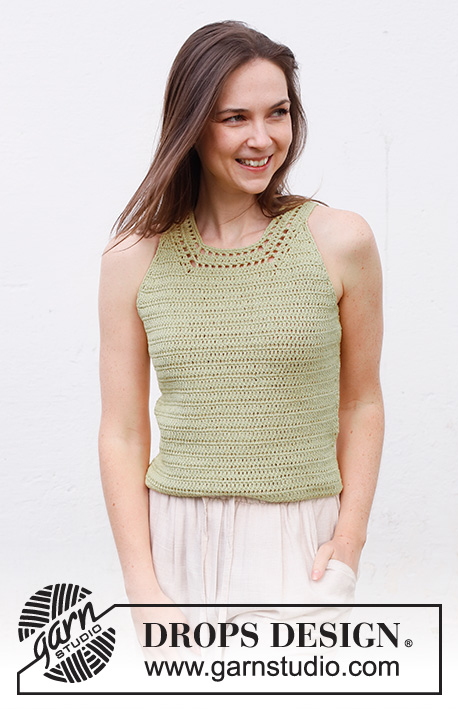 |
Crocheted top in DROPS Belle. Piece is worked bottom up. Size: S - XXXL
DROPS 230-42 |
|
|
---------------------------------------------------------- EXPLANATION FOR THE PATTERN: ---------------------------------------------------------- CROCHET TIP FOR CHAIN STITCHES: If you work at the end of crochet hook the chain stitch will often be too tight. 1 chain stitch should be just as long as 1 single crochet/double crochet is wide. CROCHET INFORMATION: At the beginning of every row with double crochets work 3 chain stitches (they replace first double crochet), i.e. skip first double crochet from previous row. Work last double crochet on row in 3rd chain stitch at the beginning of previous row. At the beginning of every row with single crochets work 1 chain stitch (to replace first single crochet) i.e. skip first stitch from previous row. Work last single crochet on row in 3rd chain stitch from beginning of previous row. INCREASE TIP (applies to sides on front and back piece): Increase by working 2 double crochets in same double crochet. Increase inside 1 double crochet in each side. Continue the increased stitches in double crochets. DECREASE TIP: WORK 2 DOUBLE CROCHETS TOGETHER AS FOLLOWS: * Make 1 yarn over, insert hook in next stitch, get yarn, make 1 yarn over and pull yarn through the 2 first loops on hook *, crochet from *-* 2 times in total, make 1 yarn over and pull yarn through all 3 loops on hook (= 1 stitch decreased). ---------------------------------------------------------- START THE PIECE HERE: ---------------------------------------------------------- TOP - SHORT OVERVIEW OF THE PIECE: Work front and back piece back and forth in parts, bottom up. Sew parts together and work an edge around the neck opening on the top. FRONT PIECE: Work 74-80-88-96-108-118 CHAIN STITCHES - read explanation above, on hook size 4 MM = US 6 with DROPS Belle. Work 1 double crochet in 4th chain stitch from hook (= 2 double crochets) - read CROCHET INFO, work 1 double crochet in each of the next 70-76-84-92-104-114 chain stitches = 72-78-86-94-106-116 double crochets. Work 1 double crochet in every double crochet. REMEMBER THE CROCHET GAUGE! When piece measures 8 cm = 3⅛", increase 1 double crochet in each side - read INCREASE TIP! Increase like this every 4-4-4-5-5-5 cm = 1½"-1½"-1½"-2"-2"-2" 4 times in total = 80-86-94-102-114-124 stitches. When piece measures 26-27-28-29-30-31 cm = 10¼"-10⅝"-11"-11⅜"-11¾"-12¼", work next row as follows: Work slip stitches over the first 8-8-9-10-13-15 double crochets on row, work until 8-8-9-10-13-15 double crochets remain on row = 64-70-76-82-88-94 double crochets. Turn piece. Continue with 1 double crochet in every double crochet, and continue decreases for armhole in each side: Work the outermost 2 double crochets in each side together – read DECREASE TIP, repeat on every row 6-6-6-7-7-8 times in total = 52-58-64-68-74-78 double crochets. Now divide the front piece, and finish each part separately. LEFT FRONT PIECE (when garment is worn): Work 1 double crochet in first double crochet, work the next 2 double crochets together, work 1 double crochet in each of the next 8-10-12-14-16-18 double crochets, work the next 2 double crochets together, work 1 double crochet in next double crochet. Turn and work from mid front, AT THE SAME TIME decrease 1 stitch towards mid front and 1 stitch towards the side on every row as explained above. Decrease like this way until 4 double crochets remain on row. Work the last 4 double crochets together 2 by 2 = 2 double crochets. Cut and fasten the yarn. RIGHT FRONT PIECE (when garment is worn): Skip the middle 24-26-28-28-30-30 double crochets on front piece (14-16-18-20-22-24 double crochets remain towards the side), work 1 double crochet in first double crochet, work the next 2 double crochets together, work 1 double crochet in each of the next 8-10-12-14-16-18 double crochets, work the next 2 double crochets together, work 1 double crochet in next double crochet. Turn and work from the side, AT THE SAME TIME decrease 1 stitch towards mid front and 1 stitch towards the side on every row as explained above. Decrease like this way until 4 double crochets remain on row. Work the last 4 double crochets together 2 by 2 = 2 double crochets. Cut and fasten the yarn. BACK PIECE: Work the entire back piece the same way as front piece. ASSEMBLY: Sew side seams but leave 6 cm = 2⅜" at the bottom in each side = vents. EDGE AROUND NECK: Work an edge around the neck on front piece and on back piece. First work parts together by working a chain stitch row over each shoulder. Begin on right front piece, work 1 slip stitch at the top of tip, work approx. 3 to 11 chain stitches (divisible by 2 + 1) – remember CHAIN STITCH TIP, and fasten a slip stitch in the tip on right back piece. Cut the yarn. NOTE: Adjust the length of chain stitch row to get the correct length on top, try it on. Work a similar chain stitch row in left side. Cut the yarn. Front piece and back piece have been worked together over each shoulder. Begin at the back on left strap on back piece (= slip stitch on chain stitch row), work 1 slip stitch + 3 chain stitches in the first chain stitch (= replace first double crochet), then work 1 double crochet in each chain stitch from chain stitch row, work 2 double crochets around every row with double crochet down along left front piece until double crochets where skipped for neck (= 12-14-16-18-20-22 double crochets), work 1 double crochet in every double crochet mid front, while at the same time increasing 1 double crochet over these 24-26-28-28-30-30 double crochets (= 25-27-29-29-31-31 double crochets), work 2 double crochets around every row with double crochets up to right front piece ( = 12-14-16-18-20-22 double crochets), work 1 double crochet in every chain stitch from chain stitch row, work 2 double crochets around every row with double crochets down along right back piece until where double crochets were skipped for neck (= 12-14-16-18-20-22 double crochets), work 1 double crochet in every double crochet mid back, while at the same time increasing 1 double crochet over these 24-26-28-28-30-30 double crochets (= 25-27-29-29-31-31 double crochets), work 2 double crochet around every row with double crochets up to left back piece tip (= 12-14-16-18-20-22 double crochets). Insert 1 marker in every transition between tip and neck mid back and mid front, decrease here (= 4 markers). ROW 1: Work 3 chain stitches (replace first double crochet), (* 1 chain stitch, skip 1 double crochet, 1 double crochet in next double crochet *, work from *-* until 2 double crochets remain until marker, skip the next 4 double crochets, work 1 double crochets in next double crochet), work from (-) until 1 double crochet remains, finish with 1 chain stitch, skip 1 double crochet and work 1 slip stitch at the beginning of round. ROW 2: Work 3 chain stitches, * work 1 double crochet in each double crochet and 1 double crochet in every chain stitch until 1 double crochet remains before marker, skip the next 2 double crochets *, work from *-* the entire round, finish with 1 slip stitch in 3rd chain stitch at the beginning of round. ROW 3: Work 3 chain stitches, (* 1 chain stitch, skip 1 double crochet, 1 double crochet in next double crochet *, work from *-* until 1 double crochets remain until marker, skip the next 2 double crochets, work 1 double crochets in next double crochet*), work from (-) until 1 double crochet remains, finish with 1 chain stitch, skip 1 double crochet and work 1 slip stitch at the beginning of round ROW 4: Work 1 single crochet in/around every chain stitch. CROCHET EDGE AROUND ARMHOLE: Work 1 edge around each armhole, begin at the bottom where armholes were bind off, work 1 single crochet in every double crochet, 2 single crochets around every row with double crochet and 1 single crochet in every chain stitch. Work around the entire armhole and finish with 1 slip stitch in first single crochet. Work the same way around the other armhole. |
|
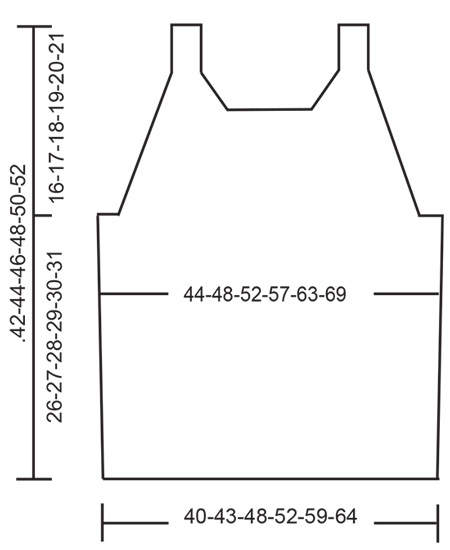
|
|
|
Have you made this or any other of our designs? Tag your pictures in social media with #dropsdesign so we can see them! Do you need help with this pattern?You'll find tutorial videos, a Comments/Questions area and more by visiting the pattern on garnstudio.com. © 1982-2024 DROPS Design A/S. We reserve all rights. This document, including all its sub-sections, has copyrights. Read more about what you can do with our patterns at the bottom of each pattern on our site. |
|







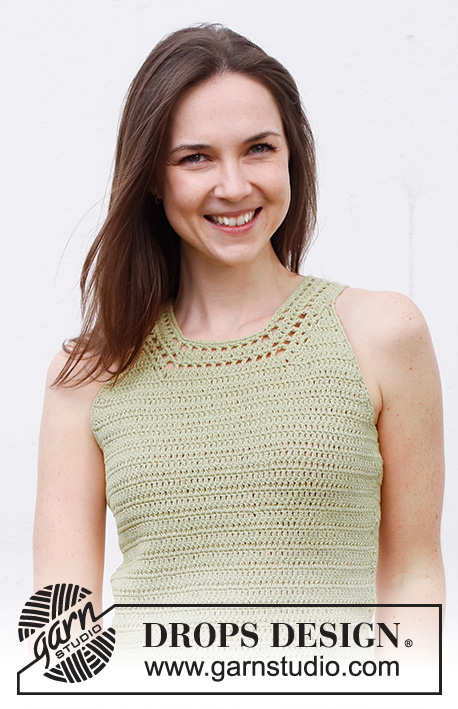
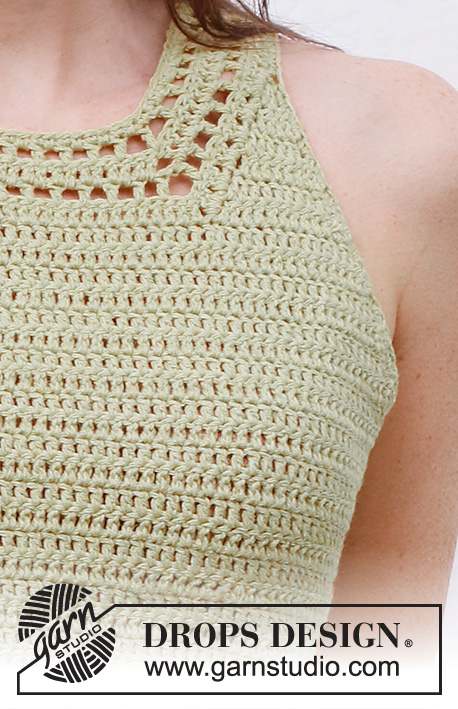



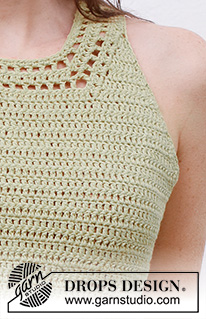






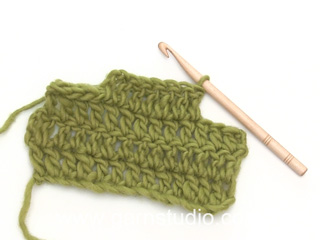
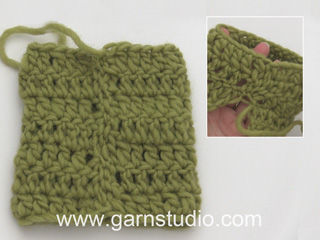























Comments / Questions (11)
Hoi, ik heb net 1 kant klaar maar ik merk dat ik het voorpand nogal kort vind. Klopt het dat dit een kort patroon is? Ik heb graag dat het tot mijn heupen valt. Kan ik dan het best na de eerste 8 cm, nog 5 cm bij doen? Of valt dit dat dan veel te lang? Ben anders bang dat met het bukken of armen omhoog te doen, er huid te zien zal zijn
22.07.2023 - 08:39DROPS Design answered:
Dag Petra,
Het is inderdaad een kort patroon. Je zou er inderdaad nog een aantal centimeters aan kunnen haken, alleen zie je dat wel, omdat je de andere kant op haakt. Houd er ook rekening mee dat je misschien moet meerderen omdat de heupen breder zijn (afhankelijk van hoe lang je hem maakt.
24.07.2023 - 20:08Dzień dobry. Na końcu części PRAWY PRZÓD i LEWY PRZÓD jest napisane: "Zamykać tak samo, aż zostaje 4 słupki. Przerobić każde 2 kolejne słupki z 4 ostatnich słupków razem = 2 słupki". Skoro każdy pierwszy słupek w rzędzie ma być zastąpiony 3 oczkami łańcuszka, to jak te 3 oczka łańcuszka przerobić razem z następnym słupkiem?
10.07.2023 - 21:17DROPS Design answered:
Witaj Aniu, zamykasz w ten sposób ponad 4 ostatnimi słupkami. Patrz ZAMYKANIE OCZEK: PRZERABIAĆ 2 SŁUPKI RAZEM, wykonasz tą sekwencję 2 razy. Pozdrawiamy!
11.07.2023 - 17:31Re: Left front piece ( when garment is worn) What does this mean? Am I supposed to crochet this piece while wearing the garment?? This makes nos sense. Can you please clarify what one is to do when working this part?
21.06.2023 - 21:00DROPS Design answered:
Hi Darlene, This means that the piece you are working is the left front piece on the finished garment. Happy knitting!
22.06.2023 - 05:36Bonjour, Je ne comprend pas bien les diminutions en lien avec les 4 marqueurs. Où se font-elles. Est-ce qu’il y a des diminutions au milieu dos et devant? Donc, on diminuerait 4 fois? Et, rang 1: crocheter de" (-)" , je ne comprend pas ce que cela implique comme répétition. Il n’y a pas de repère concernant le nombre de brides restantes à chaque rang. Merci!
09.08.2022 - 22:12DROPS Design answered:
Bonjour Mme Brisli, on diminue effectivement 4 fois car on place 4 marqueurs (2 pour le devant et 2 pour le dos, entre le milieu et chacune des pointes) cf réponse précédente - répétez de *à* jusqu'à ce qu'il reste 2 brides avant le marqueur, sautez ensuite 4 brides et répétez la séquence; autrement dit, vous allez ainsi crocheter tout le tour (1 ml, sautez 1 bride, 1 bride dans la bride suivante) en sautant 4 brides à chacun des marqueurs = vous allez diminuer un total de 16 mailles (4 mailles à chaque marqueur). Bon crochet!
10.08.2022 - 08:52Bonjour! pouvez-vous m',expliquer où placer les marqueurs "entre chaque pointe » svp? Merci!
09.08.2022 - 20:37DROPS Design answered:
Bonjour Mme Brisli, vous devez placez les marqueurs entre chacune des pointes du haut du dos et du devant et le milieu du dos/le milieu du devant, autrement dit, dans le schéma, les marqueurs seront au milieu de la partie oblique. Bon crochet!
10.08.2022 - 08:46Me gustaría que las explicaciones también fueran en español
28.05.2022 - 17:35DROPS Design answered:
Hola Lourdes, Es un modelo de la nueva colección y ya está disponible en español.
30.05.2022 - 12:43Hoi, Ik ben een beginnende haker en ik zag de mooie patronen en garen. Maar ik zag dat er nergens bijstond voor welke moeilijkheidsgraad ( voor de beginnende haker) de patronen zijn? Ik zou heel graag vanalles bestellen, maar ik weet niet waar beginnen. Lieve groetjes Emilie
27.05.2022 - 20:51DROPS Design answered:
Dag Emilie,
We hebben inderdaad geen moeilijkheidsgraad aangegeven, omdat het per persoon heel verschillende is en afhankelijk van welke technieken je beheerst. Bij elk patroon zijn video's toegevoegd van de gebruikte technieken. Je kunt ook de vaak gestelde vragen raadplegen en bij tips en hulp kijken voor basislessen. Je kunt ook altijd een vraag achterlaten, zodat iemand van ons kan helpen. Of bij een breiclub of verkooppunt in de buurt vragen om hulp.
28.05.2022 - 18:40Nuit sous les figuiers
19.01.2022 - 15:16Stepping out
19.01.2022 - 06:10Sommerminner
17.01.2022 - 12:42